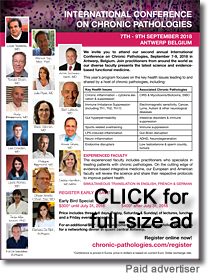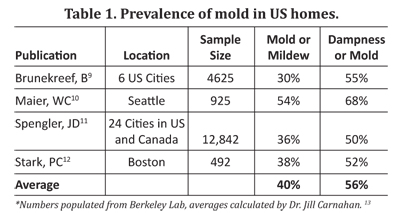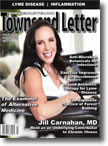Page 1, 2, 3
Factors That Affect How Mold-Related Illness Presents in the Body
How mycotoxins affect an individual depends on hundreds of factors, which is part of the reason definitive diagnostics remain complex. Factors that influence how mycotoxin exposure presents include the following:
- Nutrient deficiency (which could be due to either diet or poor absorption),
- Other microbial infections,
- Alcohol and drug use,
- Other autoimmune or degenerative diseases,
- Genetics – particularly HLA DR typing and MTHFR; and
- Method of exposure: Inhalation and ingestion are most common. Surprisingly inhalation may be many times more toxic than ingestion. However, transdermal should not be ruled out.4 Those who work in agriculture and some industrial occupations could have a higher risk of exposure.3
How Should a Clinician Approach the Patient with Suspected Mold-Related Illness?5
• Ask about the above symptoms. Create a handy ROS sheet that pertains to water-damaged buildings (WDB) and mold-related illness.
• Take a comprehensive medical history including birth and in utero exposure.
• Some common questions… |
| |
- Has your work or home recently been flooded or had water damage?
- Have you noticed mold in your work or home?
- Are any of your family members or coworkers chronically sick or experiencing similar symptoms to you?
- Do your symptoms get worse on rainy days?
- What do you do for work?
- What are your hobbies? Looking for other areas of exposure.
- Are you exposed to dust, chemicals, or fumes at work?
- Do your symptoms change when you're in a particular location? (Keep in mind, sometimes when a person is ill due to mold exposure they increasingly stay at home, which worsens their condition if that's the source.)
|
| • Be sure to rule out other conditions. |
 Additionally, you can have them take the Visual Contrast Sensitivity test.6 This test can be taken at home, costs $15 online or can be done in office. It checks their ability to distinguish between very similar shades of black and gray. The inability to differentiate between slight color variations is a sign of neuroinflammation that can be caused by mycotoxins and other biotoxins. You can order a full panel of urinary mycotoxins through Real Time Labs or Great Plains Labs to document exposure to mycotoxins. I frequently order inflammatory markers on routine lab work as well as including, HLA typing, C3a, C4a, VEGF, MMP-9, MSH, PA-1 activity, TGF-beta, VIP, ADH/Osm, APA, ACA, Leptin/adiponectin, amylase/lipase, Ig levels and subclasses, ANA, and other viral and atypical bacterial infectious titers. Additionally, you can have them take the Visual Contrast Sensitivity test.6 This test can be taken at home, costs $15 online or can be done in office. It checks their ability to distinguish between very similar shades of black and gray. The inability to differentiate between slight color variations is a sign of neuroinflammation that can be caused by mycotoxins and other biotoxins. You can order a full panel of urinary mycotoxins through Real Time Labs or Great Plains Labs to document exposure to mycotoxins. I frequently order inflammatory markers on routine lab work as well as including, HLA typing, C3a, C4a, VEGF, MMP-9, MSH, PA-1 activity, TGF-beta, VIP, ADH/Osm, APA, ACA, Leptin/adiponectin, amylase/lipase, Ig levels and subclasses, ANA, and other viral and atypical bacterial infectious titers.
How Prevalent Are Moldy Buildings?
We now spend 90 percent of our time indoors, which adds to the impact indoor air pollution can have on our health.7 Molds can grow in a variety of climates and only need 24 to 28 hours of dampness to start growing.8 Estimates vary on how many homes have mold growth; however, overall, they suggest moldy buildings are more prevalent than many realize.
These reports are a few of the studies that have led to the widespread and common claim that about half of all American homes have dampness and mold growth.

Though, this potentially high prevalence of mold growth across the country is a definite reason for concern, there's a lot of good news that comes with environmentally acquired illness. First and foremost, is the ability to remove a patient from the environment or implement remediation to improve their overall health. Diagnosis, treatment, and prognosis of mold-related illnesses have a positive potential outcome once the origin of the assault is identified and removed.
This is where awareness and education come in. As a country, we are in denial at how significant the role mold and mycotoxins play in our health, and it's time we all paid better attention.
Mold in Our Food
Another major source of mold is our food supply. Most of the studies on mycotoxins in the food supply revolve around animal feed. Overall, we could use more investigation on mycotoxins in our food, though the United Nations estimates that about 25 percent of the world's food supply is impacted by mycotoxins – primarily grains, corn, and anything that is stored for long periods of time.14 Research has found that most acute mycotoxicosis cases have occurred due to mycotoxins in the food supply.15
Dr. Jill's Low-Mold Diet
Foods That Must Be Avoided
Avoid sugar and sugar-containing foods: table sugar and all other simple, fast-releasing sugars such as fructose, lactose, maltose, glucose, mannitol and sorbitol. This includes honey and natural sugar syrup type products such as maple syrup and molasses. This also includes all candies, sweets, cakes, cookies, and baked goods. Sweetleaf whole leaf stevia concentrate may be used in moderation.
High sugar fruits:
- Avoid pineapple, mango, banana, melons, oranges, and grapes.
- Organic berries, apples and lemon/lime are okay.
Packaged and processed foods:
- Avoid canned, bottled, boxed, and otherwise processed and pre-packaged foods as they more often than not contain sugar of one type or another.
- Canned – Baked beans, soups, ready-made sauces.
- Bottled – Soft drinks, fruit juices, all condiments and sauces.
- Boxed/Packaged – Ready-made meals, breakfast cereals, chocolate/candy, ice cream, frozen foods.
Mold- and yeast-containing foods:
- Cheeses: All cheese, especially moldy cheeses like Stilton are the worst, buttermilk, sour cream, and sour milk products.
- Alcoholic drinks: beer, wine, cider, whiskey, brandy, gin, and rum.
- Condiments: vinegar and foods containing vinegar, mayonnaise, pickles, soy sauce, mustard, relishes.
- Edible fungi, including all types of mushrooms and truffles.
- Processed and smoked meats: sausages, hot dogs, corned beef, pastrami, smoked fish, ham, bacon.
- Fruit juices: All packaged fruit juices may potentially contain molds.
- Dried fruits: raisins, apricots, prunes, figs, dates, etc.
Foods Okay to Be Eaten in Small Amounts
- Gluten-free grains: brown rice, quinoa, buckwheat, millet, teff, certified gluten-free oats
- High starch vegetables and legumes: sweet corn, potatoes, beans and peas, lentils, sweet potatoes, squashes, turnips, parsnips.
- Fruits: low sugar types such as berries, apples, pears and peaches.
Foods to Be Eaten Freely
- Organic pastured animal products: beef, bison, veal, lamb, buffalo, wild-caught seafood, poultry, pastured eggs.
- Low-carbohydrate vegetables: broccoli, spinach, cauliflower, kale, cabbage, arugula, chard, cucumber, peppers, tomato (fresh only), onion, leek, asparagus, garlic, artichokes.
- Raw nuts and seeds: sunflower seeds, pumpkin seeds, flax seeds, chia seeds, almonds, low-mold nuts. (No peanuts, walnuts, pecans, cashews, Brazil nuts)
- Healthy Fats: extra virgin olive oil, coconut oil, coconut milk, ghee, avocado, organic butter.
- Other: tempeh, miso, apple cider vinegar
- Beverages: filtered water, non-fruity herbal teas, mineral water, fresh veggie juice.
|
Page 1, 2, 3 |
![]()
![]()
![]()
![]()






